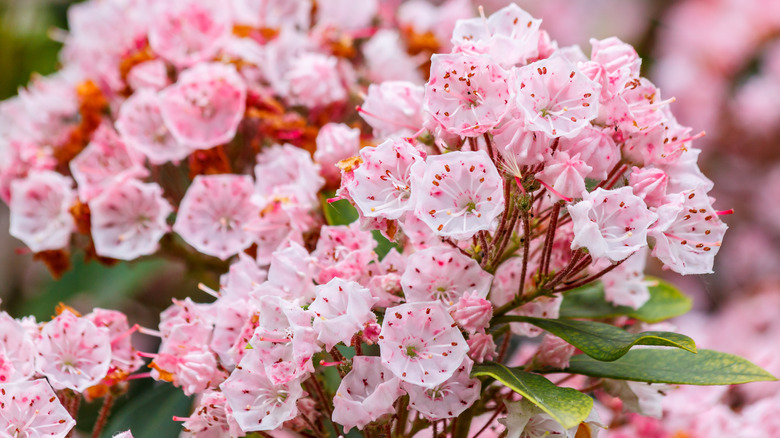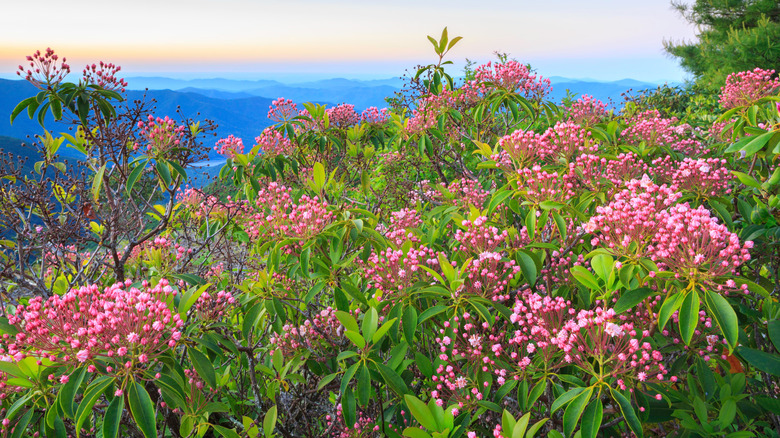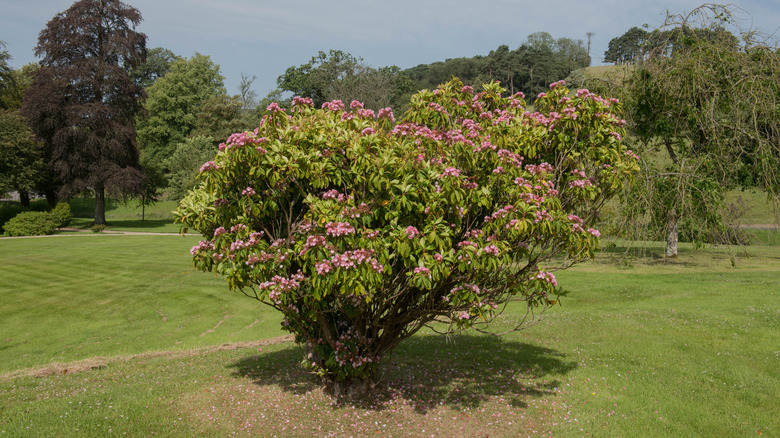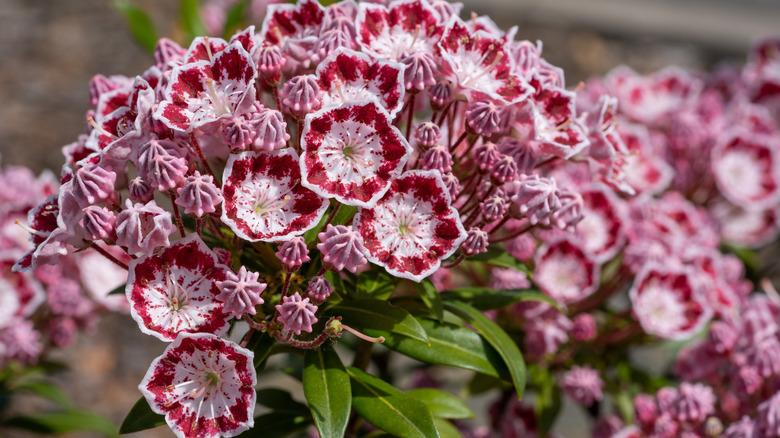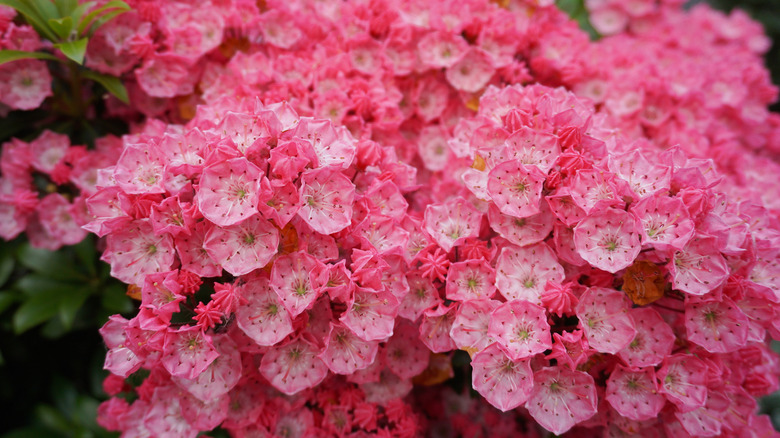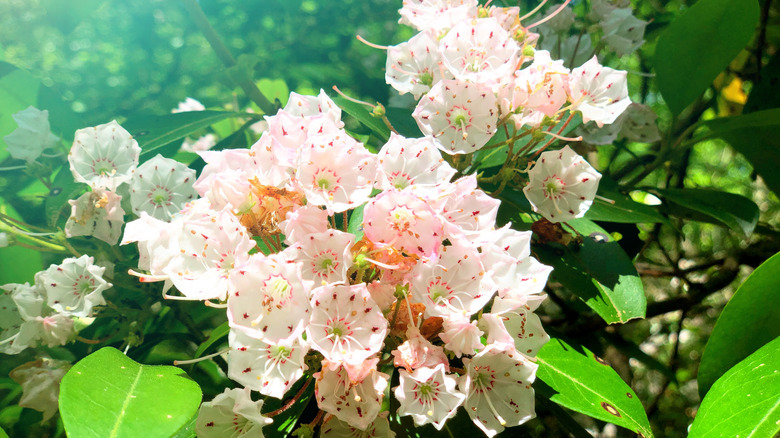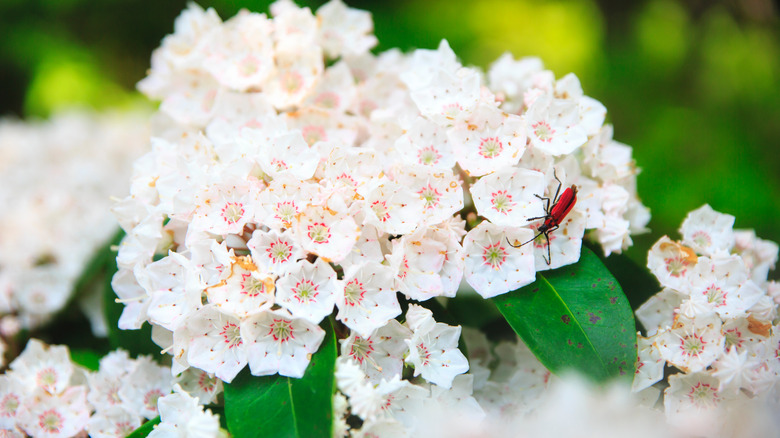Mountain Laurel: Everything You Need To Know Before Planting
Mountain laurel (Kalmia latifolia) is a shade-tolerant shrub with unique blooms that come in a range of white and pink hues, as per the Lady Bird Johnson Wildflower Center. The delicate flowers are bell-shaped and grow in clumps along the shrub while a ring of stamen shoots out from the center of each bloom. This shrub also features oval-shaped leaves that can be light-green to dark-green in color. They are between 2 and 5 inches in length, according to the Arbor Day Foundation. The plant itself also ranges in size, averaging 7 to 15 feet in both height and width when fully grown. While the shrub only blooms in the late spring and early summer, the leaves are present all year round.
This plant has an interesting history. It earned its name from Swedish botanist Pehr Kalm during an expedition to North America in 1748, as per Lovingly. He nicknamed the shrub "spoon tree" due to its alternative uses by Native Americans, who regularly fashioned spoons and other tools out of the various components of the plant. Despite its name, mountain laurel does not limit itself to mountain regions and can be grown in various climates and locations. It has also become the official state flower in more than one state — Connecticut and Pennsylvania. When provided with the ideal growing conditions, mountain laurel is a beautiful and hardy addition to any garden. Here are some tips on how to grow and care for mountain laurel.
How to use mountain laurel in the garden
Due to the shade-loving nature of mountain laurel, you don't have to worry too much about placement in your garden as it won't need to compete with other plants for a spot in direct sunlight. You can even consider planting your mountain laurel underneath other larger shrubs and trees, as it will take advantage of the filtered light coming through from above, according to Gardening with Charlie Nardozzi. However, keep in mind that if you consider this option, you will need to make sure that your mountain laurel gets some sun during the day to ensure proper bloom growth.
If your property borders a natural woodland area, you can plant mountain laurel along the edge to add some color during the growing months and a natural boundary to your outdoor space. In this same vein, mountain laurel looks great planted against walls and fences. It also grows well near other broadleaf evergreens, including leatherleaf viburnum, gardenias, and rhododendrons.
Shrubs, like mountain laurel, are perfect for planting along the side of your house as foundation plantings. They add a bit of natural life to the hard lines and materials of a house and can disguise less-attractive features, such as lengths of siding and utility boxes, according to The Spruce. If your yard does not contain trees, mountain laurel can add a bit of texture that will break up wide expanses of lawn.
How to grow mountain laurel
There are multiple ways to plant mountain laurel in your yard or garden, including from seeds, seedlings, and propagation, according to Gardener's Path. The most time-consuming method is growing from seeds. First, you will need to place the seeds on a dampened paper towel in a plastic bag and refrigerate them for approximately eight weeks. Then place the seeds in small growing pots that are filled with peat. They will need direct light for about a month. Only after one growing season has passed can you plant the seedlings in the ground.
If you purchase seedlings directly from the nursery, you will be able to skip the above process and go straight to planting them in your yard. For this, you will need a trowel and some compost. First, dig holes that are twice the size of the seedling's root ball and sprinkle some compost in the hole before placing the seedling inside. As you fill in the hole, water a couple of times to ensure the roots have enough moisture to grow. If you are planting multiple seedlings, just make sure to leave 5 to 10 feet of space between each hole.
The last option for planting mountain laurel is through propagation. This involves cutting healthy branches from the host plant that are about 6 to 8 inches in length. You will then plant them in growing pots for about four to six months before moving them to the outdoors once fully rooted.
How to care for mountain laurel
Mountain laurel grows in a wide range of climates and mainly thrives in USDA hardiness zones 4 through 9, according to The Spruce. The fact that they don't need direct sunlight makes them a great option for a wide variety of outdoor landscapes. Note that some direct sunlight is perfectly fine, but too much will change the color of the leaves. Alternatively, excessive shade will prevent healthy bloom growth. Although mountain laurels are often found growing near swamps and bodies of water, they will not do well if left in perpetually moist soil. The soil should be on the acidic side and drain well.
A benefit to growing mountain laurel is that the shrub is resistant to drought, allowing it to survive hot summers. However, you should regularly provide water, especially during the summer growing season. If you live in a particularly hot climate, it's even more important that you plant mountain laurel in a shady spot. For best bloom results, consider adding a bit of fertilizer to the soil around your mountain laurel every spring.
One other important part of caring for mountain laurel is pruning. While you can feel free to shape the shrub to your liking at any point, it's also crucial to cut back dead flowers and branches regularly to encourage healthy growth. Make sure to prune once the flowers are done growing.
Varieties of mountain laurel
Mountain laurel is native to the eastern regions of North America, as per the Missouri Botanical Garden. This plant comes in various sizes with colors ranging from white to pink, red, and purple. While typically the size of a shrub, some varieties can resemble small trees, growing up to 15 feet in height and width, according to the Garden Lovers Club. Smaller dwarf varieties hover around 7 feet in height and width, although some grow smaller than this.
Among the many varieties of mountain laurel is the olympic fire, which features multi-colored blooms in pink and white hues. Known for growing faster than the average mountain laurel variety, a mature olympic fire will hit between 5 and 10 feet in height. Two dwarf varieties that mature at around 3 feet in height are called elf and minuet. The differences between the two varieties can be seen in the color of their flowers — elf has white blooms while minuet features pink and red blooms. The peppermint is aptly named for the design of its blooms, which are white with red stripes. This is a larger variety, growing to 10 feet in height. The carousel is one of the flashier varieties, marked by pink flowers with red dots that stain the interiors. It hits around 8 feet tall when fully grown. You might also be interested in the all-white snowdrift, a dwarf variety growing to 5 feet in height.
Is mountain laurel toxic?
In short, mountain laurel is an incredibly toxic plant to both humans and animals alike. All components of the shrub contain grayanotoxins, which have a poisoning effect when consumed, according to SFGATE. Signs of poisoning can range from vomiting and diarrhea to arrhythmia, coma, and death if ingested in excessive quantities. If you or someone in your family has accidentally ingested any part of mountain laurel, contact your local poison control center or emergency hospital immediately for assistance. The same goes for pets. Treatments for mountain laurel ingestion include pumping the stomach with activated charcoal and administration of a laxative to move the substance through the body as quickly as possible.
The best way to avoid accidental mountain laurel toxication is to prevent small children and animals from accessing the plant. You can plant it in an area of your yard that can be sectioned off with fences or other barriers to physically prevent curious children and pets from getting close to the shrubs. In the case of pets, you can train them to stay away from the plant with positive reinforcement techniques or use a bitter spray to dissuade them from ingesting the plant. Regardless of the method that works best for you, it is important to always supervise children and pets when in the proximity of mountain laurel.
How to repot mountain laurel
While mountain laurel isn't commonly grown in pots due to its large size, some dwarf varieties can be grown in containers, as per Gardening Know How. It is important to make sure you purchase a variety that stays compact even when fully matured, such as elf or minuet, which both grow to 3 feet. You will also need to house these varieties in a pot large enough to avoid the roots becoming bound. If this happens, your mountain laurel will cease to thrive as there won't be enough soil to hold water and provide the plant with nutrients. With container-grown mountain laurel, you will also need to provide extra water when compared to their soil-grown counterparts as they will absorb it more quickly. Keep in mind that potted mountain laurel is not a houseplant and should be placed somewhere outdoors.
You will only need to repot your mountain laurel if it shows signs of becoming too big for its current container, especially if it is still maturing. As with garden-grown mountain laurel, you will need a well-draining and slightly acidic soil and some compost to get started, according to Gardener's Path. Carefully remove the plant from its old container and knock off the excess dirt. Add a layer of soil to the new container and place the root ball inside, making sure it is slightly raised above the lip of the container. Fill in with soil and water generously.
Mountain laurel pests and diseases
Mountain laurel is susceptible to several pests and diseases that can harm its growth and potentially kill it. One insect, the Red Mountain Laurel Mirid, is red and black with an oval-shaped body, according to Texas A&M Agrilife Extension. This bug loves to feed on the mountain laurel and can cause significant damage to the leaves in large numbers. The genista caterpillar is another common pest that is yellow and brown and lays eggs on mountain laurel. Its larvae feed on the various parts of the plant, often causing damage to the leaves as well. Both pests can be treated with insecticides. Other mountain laurel pests include lace bugs, weevils, scale insects, and borers, as per Bartlett Tree Experts.
The diseases that infect mountain laurels are typically fungal in nature, including leaf spot disease and root rot. The former affects the shrub's leaves and is evidenced by small brown spots. This disease can significantly reduce the number of leaves present. It can be caused by too much shade and excessive contact with water. Root disease starts in the plant's roots and slowly destroys it moving upward. It is commonly caused by poorly draining soil and too much watering. Both diseases can be treated with fungicides. You should also get rid of infected plants to avoid continued spread.
